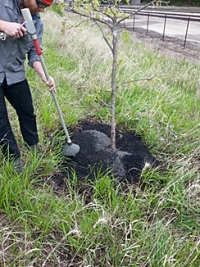We can see how the park is taking shape with the establishment of native plants and trees. More flowers are blooming this year than ever. What we can’t see are the nutrients in the soil that are contributing to this change.
The change from brownfield to greenspace makes Three Bridges Park a perfect spot to examine how changes in nutrients affect native habitats. Healthy soil is essential to having a healthy ecosystem because soil is a living, breathing (yes, breathing) thing that is complex with beneficial microbes, bacteria and fungi associated with the root system of plants and trees.
We are very excited to have begun a unique research project in partnership with Bryant Scharenbroch from the Morton Arboretum that will look at the effect additional nutrients have on the health of Bur Oaks, prairie plants and soil. We will apply four different treatments on 56 plots throughout the park, allowing us to compare different treatments and to get a better understanding of what treatment type works best for each kind of plant.
But Jeff, what are the treatments? Well, I’m glad you asked. The four treatment types are biochar, biosolids, biochar/biosolids combined and the “control”—no treatment. Biochar is wood that has been burned in a low/no oxygen environment, which creates a charcoal-like consistency. It helps to retain water and water-soluble nutrients, increase soil fertility and protect against soil-borne diseases. Biosolids, or Milorganite—made right here in Milwaukee!—is composed of heat-dried microbes that have digested organic material in wastewater. Once applied, it slowly releases nitrogen to be available for plants.
The treatments were applied with the use of an air knife (shown above); which pressurizes up to 250 psi and directs air. The benefit of using this tool for “tilling” is it doesn’t damage the root system of a tree, therefore reducing the amount of stress. For the control plots the soil was “tilled” but no treatments were added, to ensure that we have the best scientific comparison.
The long-term plan for this research is to monitor the health of the soil and the growth/health of the above-ground vegetation. We will conduct soil tests to measure levels of nutrients, beneficial microbial fungi, respiration (remember, soil breathes!) and temperature and we will weigh and analyze above-ground plant mass to study correlation between soil health and vegetation health.
Because remediation of soil takes a long time, this research project theoretically will be in the works for over 10 years, and over that time we hope to see the soil health improve. Just like reading a good book, this study is going to take some time, and we’re excited to learn the whole story!





